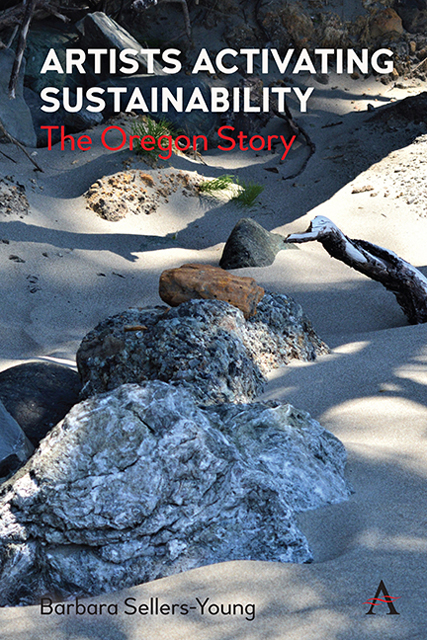Book contents
- Frontmatter
- Dedication
- Contents
- Acknowledgments
- List of Figures
- Introduction: Art, Environment and Metaphor
- 1 Environmental Activism, Arts and the Land of Eden Landscape One: High Desert Basin and Range
- Landscape One High Desert Basin and Range
- Landscape Two Columbia Gorge and Plateau
- Landscape Three Cascade Range
- Landscape Four The Willamette Valley
- Landscape Five Rogue River Valley
- Landscape Six Oregon Coast and Coast Range
- Index
2 - The Murals of Vale: Gateway to Oregon
Published online by Cambridge University Press: 10 January 2023
- Frontmatter
- Dedication
- Contents
- Acknowledgments
- List of Figures
- Introduction: Art, Environment and Metaphor
- 1 Environmental Activism, Arts and the Land of Eden Landscape One: High Desert Basin and Range
- Landscape One High Desert Basin and Range
- Landscape Two Columbia Gorge and Plateau
- Landscape Three Cascade Range
- Landscape Four The Willamette Valley
- Landscape Five Rogue River Valley
- Landscape Six Oregon Coast and Coast Range
- Index
Summary
The smells riding on the wind conjured up some of her best memories—hayrides, days at the fair, corn feeds at the Legion Hall with freshly picked corn boiling in huge galvanized tubs, fresh tomatoes and ripe melons.
Nancy Judd MinorVale near the Idaho border was fashioned, as were other geographic areas of eastern Oregon, by a number of young volcanoes that erupted about 3 million years ago and covered large areas with lava flows of fluid basalt. The remains of the volcanoes are a series of faults that contain warm or hot ground water that bubbles up and sometimes mixes with local streams and rivers across eastern Oregon. The geothermal aquifer in the Vale area covers approximately 40 acres along a major fault zone. The aquifer discharges into the Malheur River primarily through hot springs with probable additional discharge through the stream bed below river level. These hot springs were a draw for groups beginning with the small roving bands of Paiutes and in the eighteenth century the travelers on the Oregon Trail.
The landscape around Vale is semiarid with limited rainfall but when the rain does come it can create major floods as it did in 1925 and 1957. Two irrigation projects, the Vale Project of the 1930s and the Bully Creek Dam Project on the Malheur River of the 1960s, controlled for potential floods and opened new land to farming and ranching. In the 1970s, there was a large-scale rangeland rehabilitation program of replanting versions of wheat grass and rotation of grazing to mitigate the extensive damage done by overgrazing. Today, a variety of row crops are grown in the valley with dairy cows and beef cattle in the low hills. Each week there is a livestock auction in Vale.
Vale (population around 2.000) is noted for being the first stop in Oregon for settlers on the 2,170-mile Oregon Trail. A memorial to the trail, Keeney Pass Interpretive Site, named for early resident Jonathan Keeney, is on the outskirts of the city center. This designated Oregon National Historic site provides an opportunity to take a less than mile walk along the dusty terrain of the original wagon ruts of Keeney Pass and read along the way stories of the Oregon Trail.
- Type
- Chapter
- Information
- Artists Activating SustainabilityThe Oregon Story, pp. 49 - 60Publisher: Anthem PressPrint publication year: 2022



